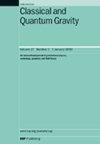The motion of twisted particles in a stellar gravitational field
IF 3.6
3区 物理与天体物理
Q2 ASTRONOMY & ASTROPHYSICS
引用次数: 0
Abstract
In this work, we explore the motion of a twisted particle possessing intrinsic orbital angular momentum (OAM) as it traverses a weak stellar gravitational field, which we approximate using a polytropic model. We disregard the spin characteristic of the twisted particle, modeling it as a massless complex twisted scalar wave packet to simplify its interaction with gravitational fields. Building on this simplification, we determine the trajectory of this twisted particle by using the center of its energy density and investigate the gravitational birefringence induced by its OAM. In a weak field approximation, we find the gravitational birefringence-OAM relationship parallels that with spin, as described by the Mathisson-Papapetrou-Dixon equations. This indicates that the gravitational birefringence induced by OAM can potentially exceed that induced by spin by several orders of magnitude, significantly enhancing its detectability. To broaden our analysis, we introduce a nonminimal coupling term, , into the Lagrangian, resulting in the modified expression . This adjustment is necessitated by the quantization of the scalar field in curved spacetime. We then explore the effects of this term on the motion of the twisted particle. Our findings show that the trajectory of the twisted particle under nonminimal coupling (λ ≠ 0) differs from that in the minimal coupling scenario (λ = 0). Specifically, for a positive nonminimal coupling constant λ, the trajectory of the twisted particle is expected to deviate away from the stellar center, compared to the minimal coupling scenario.恒星引力场中扭曲粒子的运动
在这项工作中,我们探索了一个拥有固有轨道角动量(OAM)的扭曲粒子在穿越弱恒星引力场时的运动,我们用一个多向性模型对其进行了近似。我们忽略了扭曲粒子的自旋特性,将其建模为一个无质量的复杂扭曲标量波包,以简化其与引力场的相互作用。在这一简化的基础上,我们利用扭曲粒子的能量密度中心来确定其运动轨迹,并研究其 OAM 引起的引力双折射。在弱场近似中,我们发现引力双折射-OAM 关系与自旋关系相似,如马蒂森-帕佩特罗-狄克逊方程所描述的那样。这表明由 OAM 引起的引力双折射有可能超过自旋引起的引力双折射几个数量级,从而大大提高了其可探测性。为了拓宽分析范围,我们在拉格朗日中引入了一个非最小耦合项 ,从而得到了修正后的表达式 。这一调整是由于标量场在弯曲时空中的量子化所必需的。然后,我们探讨了这个项对扭曲粒子运动的影响。我们的研究结果表明,在非最小耦合(λ≠0)条件下,扭曲粒子的运动轨迹与最小耦合(λ=0)条件下的轨迹不同。具体来说,与最小耦合情况相比,对于正的非最小耦合常数λ,扭曲粒子的运动轨迹预计会偏离恒星中心。
本文章由计算机程序翻译,如有差异,请以英文原文为准。
求助全文
约1分钟内获得全文
求助全文
来源期刊

Classical and Quantum Gravity
物理-天文与天体物理
CiteScore
7.00
自引率
8.60%
发文量
301
审稿时长
2-4 weeks
期刊介绍:
Classical and Quantum Gravity is an established journal for physicists, mathematicians and cosmologists in the fields of gravitation and the theory of spacetime. The journal is now the acknowledged world leader in classical relativity and all areas of quantum gravity.
 求助内容:
求助内容: 应助结果提醒方式:
应助结果提醒方式:


